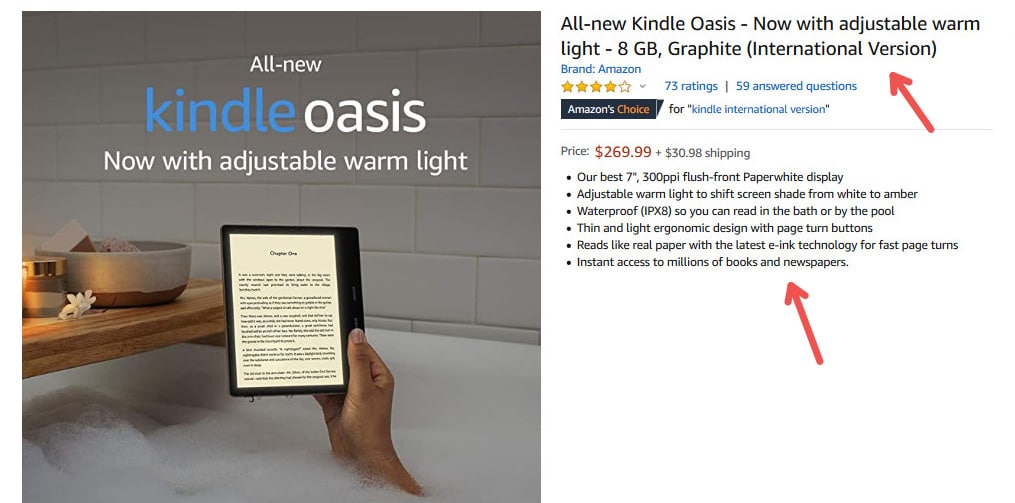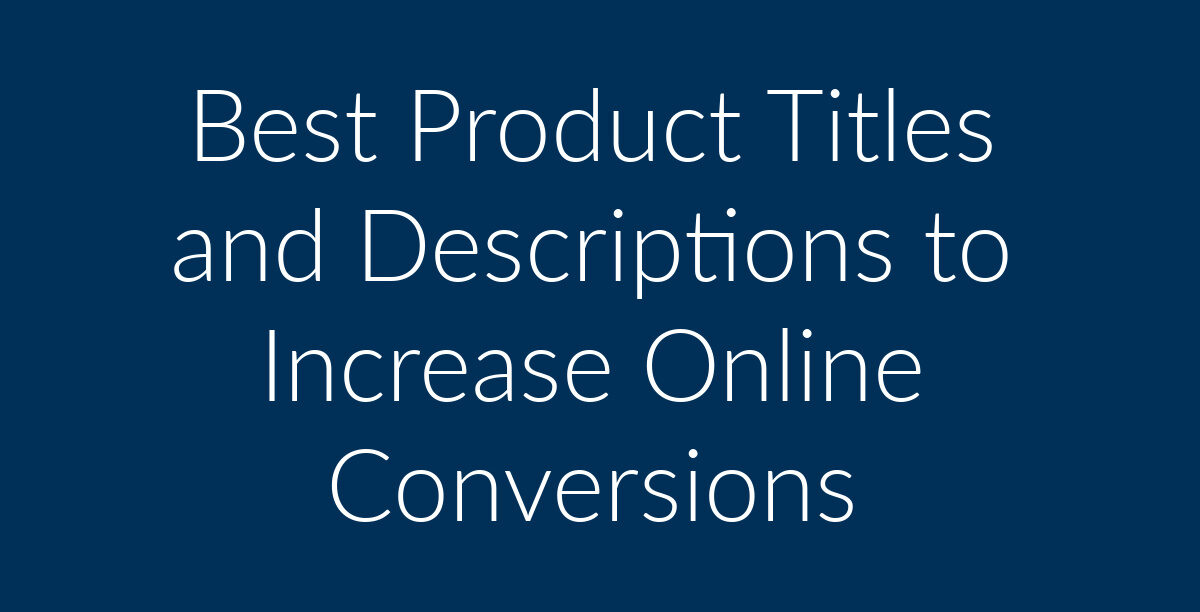Did you know that product titles and descriptions can have a very big impact on your online conversion rate? Yet most people neglect this aspect of running their eCommerce stores! Hi, my name is Francisco, and I am the owner of Planet Marketing, a Digital marketing agency. My company specializes in Google Ads, Facebook Ads and eCommerce setups. I have been doing this for decades. In that time, I have helped quite a number of businesses achieve growth in the cutthroat environment in which we are all operating today. You too can benefit from the expertise that I have gathered along the way. In this article, I am going to;
- Show you why product titles and descriptions matter in eCommerce.
- Give tips to help businesses improve their eCommerce conversion rates.
- Give you the best product titles and descriptions to increase online conversions.
Do Product Titles and Descriptions Matter in eCommerce?

As a business owner, you are ever engaged in a struggle to grow your business. Now, there are many things that you can do to achieve this goal. You could, as an example, focus on SEO. This allows you to get organic traffic. One thing to note is that organic traffic is the best since you are not paying for it. All that you need to do is to create content. Once it has started to rank, you will start reaping the rewards.
Or maybe your have done the hard work on Social Media. As said above, I am also an expert on Facebook Marketing. Check out my Facebook Ads Marketing course if you want to learn more. Perhaps you have been running ads on the platform. When people click on these ads, they get taken to your website where you have the opportunity to turn them into customers. But what does this all mean? Does it mean people who get to your site will automatically buy something from your?
Most Traffic is not Converted
The sad fact is that most people fail where it matters the most. They get lots of traffic from Google and from Social media, yet these people leave without buying anything. So, what do you do to convert the traffic that you worked so hard to get? As noted, there are many things that can be done to increase eCommerce conversion rates.
One such thing is to come up with kickass product titles and descriptions. Yet, when I tell people this they frown. They don’t think product names and descriptions are that important. Well, if you have this mindset, you need to think again for the following reason;
Most eCommerce businesses lose up to 20% in potential sales due to inadequate or missing product information. So, this is nothing to frown about.
How to Improve your eCommerce Conversion Rate
So, how do you improve your metrics? How do you make sure that your hard-won traffic does not simply slip through your fingers? Well, the following tricks should help businesses improve their eCommerce conversion rates;

You need to do eCommerce SEO
Yes, eCommerce SEO is a thing! Everything that we are talking about here is aimed at helping you get the most out of your eCommerce SEO. One of the biggest challenges when drafting the best product titles and descriptions to increase online conversions is that you are not only writing for humans. This is something that some people do not understand.
If you focus exclusively on humans, then you are going to have an issue. You also need to focus on Search Engines. These may be search engines like Google or native search engines such as the ones that are on Amazon. One thing that some people do is that they simply copy the product description and title from the manufacturer of the products that they are selling.
Perhaps they are too lazy to come up with their own descriptions. However, doing this can be very harmful to your SEO. Google frowns upon duplicate content, and if you copy from another site, they will rank your pages very low. So, you will not have the free traffic that everybody is looking for.
Product descriptions and titles should be customer-centric.
What or who determines the product descriptions and title? Is it the product? Or is it something else? Well, this is where most people get it wrong. They write product descriptions and titles based on their products. They forget all about the customers.
In reality, the customer determines what you say about the product. So, you have to put yourself into the mind of the customer before writing anything. Otherwise you are going to come up with product-centric descriptions and titles that do not attract any customers.
What are your customers looking for?
You also need to ask yourself what your customers are looking for as part of the process of coming up with the best product titles and descriptions to increase online conversions. It’s not enough to simply say, as an example, that I want to target people who are looking to buy men’s T-shirts. That product may appear to be simple at face value, but, in reality, there are many variations.
Some people could be looking for t-shirts to wear in summer. Others could be looking for comfortable t-shirts. Yet others could be looking for durable t-shirts. You will also have other customers looking for slim-fit t-shirts. In fact, there is no end to the variations that you can have. Once you have understood what the customer is looking for, you can then answer them in your product descriptions and titles. That way, they will be able to find your products when they carry out a search on Google or on Amazon.
Research your keywords

Keyword research is important for writing the best product descriptions and titles
Keyword research is very important when creating product descriptions and titles. What you want to do is to get a pulse on what people have been typing into search engines in relation to be products that you sell. If you sell men’s T-shirts’, as an example, then you need to ask yourself; “what are my potential customers typing into Google?”
Probably some will be typing “men’s t-shirts.” Others will probably be typing “best men’s t-shirts.” Other possible keywords include; “quality men’s T-shirts,” and “branded men’s t-shirts.” These are just examples. Keyword research helps you understand how to craft the best descriptions and titles for your products.
One way of looking at it is that producing product descriptions and titles is similar to producing content for your website or blog. Here, you also need to do keyword research. Then you need to include the keywords in your content. And your content needs to be of the highest quality.
Best approach to writing product descriptions and titles?
The product descriptions that you use are going to be dependent on the products that are in your catalog, of course. However, there are some things that are basic to all eCommerce businesses. I often get asked what should be included in the best product descriptions and titles for eCommerce. In response, I tell people the following;
The product Title
- The product title should have the relevant keywords for your product. The keywords are what people will type into search when looking for a particular product. So, if you sell men’s T-shirts, the product title and description should carry “men’s T-Shirts,” as a keyword.
- Your product title also needs to have the color or make of the product. An example would be “men’s white T-Shirts.”
- Provide as much additions information as is possible without being spammy. Such adjectives as “lovely,” “beautiful “and “amazing” should be steered clear of. As an example, you can include the brand name in the description. An example would be “Dolce & Gabbana men’s white T-Shirts.” And because there are so many rip-offs out there, you can finalize your descriptions as; “Authentic Dolce &Gabbana men’s white T-Shirts.”
The product description
So, what should be in the product description? The following information should help you come up with the best product descriptions to increase your eCommerce conversions;
- The first thing that you need to do in your product description is to reassure the buyer that what you are selling is what they are looking for.
- As is the case with the product title, the product description also needs to contain the keywords for the product that you are selling. We noted above that our keyword is “men’s T-Shirts.”
- You should also focus on important features in your product descriptions. For example, if you sell vintage cars, then this is something that you will focus on.
- Also use variations of your keywords in your product description. In fact, you can have as many keywords as you want on one description. However, it may be better to limit yourself to about 3. Doing anything more than that will make you appear spammy. There are people out there who will have product descriptions that are composed only of keywords. They do this in an attempt to game the system.
- Quality is of importance when it comes to product descriptions. That’s the reason why many people outsource this service to professionals. If you produce copy that’s full of errors, people are going to start thinking that your eCommerce business is a scam designed to steal their credit card details. So, you need to make sure that you have gotten the grammar right and that the whole thing is easy to read.
Examples of Great Product Descriptions
The following are examples of the Best Product Titles and Descriptions to Increase Online Conversions;
Example 1

Great product title and description on Amazon
In the above screenshot, you can see an example of a good product description and title. To be fair, Amazon sellers tend to go a bit overboard in this regard. But if you look at the example of a description that was produced by Amazon itself, you will see that there is no need to do that. In the above, you can take note of the following;
The title contains relevant keywords
The title talks of the “All-new” Kindle Oasis. That’s meant to appeal to people who are looking for the latest in e-ink technologies.
You also get the product/brand name. That’s “Kindle Oasis.” Among e-reader fans, this is a name that sells itself.
There is also mention of “adjustable warm light.” Back-lighting is an important feature for Kindle buyers.
There is also information about the storage on the device.
Based on the above, you will notice that you can get away with having a not so wild product title that, nevertheless, fully reveals the product for the benefit of the buyer.
The product description is also good
From the product, title, you go to the product description. As you can see in the above, there is lot’s of information that’s outlined, including the following;
- Screen resolution.
- Backlighting information
- Waterproofing
- Dimensions
- Access to books
The above description essentially answers the questions that buyers have. Most e-reader buyers are worried about screen resolution. They are also worried about backlighting. Waterproofing may be a gimmick but it’s something that most people will welcome. There is also information about the added benefit of buying a Kindle; you get access to millions of books and newspapers.
Example 2: Simple but effective

A simple but effective approach to product descriptions and titles
This approach works if your are not operating on a crowded marketplace such as on Amazon. On your own site, as an example, there is really no need for you to try and stuff keywords. You can afford a cleaner layout.
In spite of the fact that fewer words are used above, there are actually a lot of things going on on. Every last bit is designed to help convince a person who reaches this page to buy. However, note that this is done in a simple but effective way. That’s one approach that you can take.
Product descriptions do not need to be whole pages long, as is often the case on Amazon. I can safely say most people on Amazon are engaged in keyword stuffing in a bid to stay ahead of the pack. That’s why you will see all the conceivable keywords being thrown around in both the title and in the description.
But in the above example from Bewakoof, things are kept simple. You get the following;
Your get the product brand, which is; Destination-Isolation.
You get the type of T-Shirt; Half Sleeve
You also get details on color; Navy Blue
In the description, all the information give above is repeated, ie, brand, color, make. The whole point here is to keep everything simple and straightforward. But this product will appear when people are looking either for the brand or for the type of t-shirt. A person will probably type in “half sleeve t-shirts,” when looking for this product.



